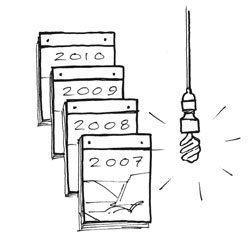Lighting accounts for approximately 5–10% of total energy use in the average American home, costing the typical household between $75 and $250 per year in electricity. That’s not a huge amount, but it is enough to justify doing something about it — especially when the advantages of energy-efficient alternatives are considered. Making the switch to energy-efficient lighting is one of the quickest, easiest, and least expensive ways to cut your home’s energy use.
This section describes different types of lighting, when and how to use each to maximize energy savings and comfort, and how to find the right products. It also discusses the most important new developments in energy-efficient lighting. New federal standards for light bulbs have received a lot of attention. We’ll discuss how the new lighting standards impact your lighting choices and dispel a number of myths to help you navigate the changing landscape in the lighting aisle of your local home store.
One note on terminology: The lighting industry uses the term “lamp” to refer to the actual source of light — what the public usually calls the light “bulb.” In this section, we use the terms “lamp” and “bulb” interchangeably.



